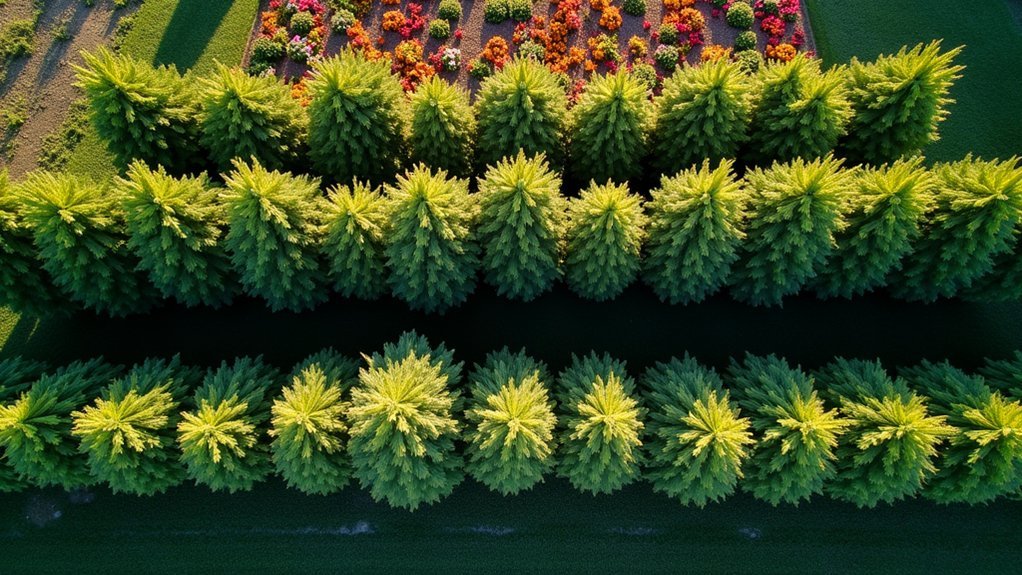The most effective multi-row windbreak designs include traditional three-tier systems, staggered five-row configurations, mixed deciduous-conifer barriers, fruit-producing arrangements, wildlife-supporting biodiversity layouts, climate-specific adaptive designs, and space-efficient two-row systems. You’ll achieve maximum protection by positioning taller species on the windward side with proper spacing (6.5-13 feet between rows), combining evergreens and deciduous trees for year-round coverage. These strategic arrangements can reduce wind speeds by up to 80% while supporting local wildlife and improving crop yields.
The Traditional Three-Tier Windbreak System

While many windbreak designs exist, the traditional three-tier system remains one of the most effective approaches for thorough wind protection.
This system features tall evergreen species on the windward side, medium-height deciduous trees in the middle, and low-growing shrubs on the leeward side, creating a stepped profile that maximizes wind deflection.
When properly implemented, this three-tier windbreak system can reduce wind speeds by up to 80% behind the barrier, greatly improving microclimate conditions for crops and livestock.
For ideal results, maintain spacing between rows of 6.5 to 13 feet, allowing each plant to reach its maximum height and fullness.
Including diverse species in each tier enhances biodiversity and creates resilience against pests and diseases, ensuring your windbreak remains effective for decades.
Staggered Five-Row Configuration for Harsh Environments
In harsh environments, you’ll need to strategically select tree species that offer complementary heights, densities, and adaptability to maximize your five-row windbreak effectiveness.
For your windward rows, consider drought-resistant conifers or sturdy deciduous trees with flexible branches that can withstand initial wind impact without breaking.
You can simplify maintenance requirements by spacing rows properly (8-12 feet apart) and implementing a staggered planting pattern that allows equipment access while reducing the need for hand-pruning.
Strategic Species Selection
Five carefully selected species create the backbone of an effective staggered windbreak design for harsh environments.
When planning your multiple-row windbreaks, you’ll need to combine fast-growing deciduous trees with dense evergreens to maximize protection. The tallest species should occupy the central row, reaching heights up to 50 feet, while shorter varieties belong in outer positions.
For ideal results:
- Pair rapid growers like Austree Willow with sturdy evergreens such as Techny Arborvitae to balance immediate and long-term protection
- Incorporate native species to enhance adaptability to local conditions and promote biodiversity
- Maintain adequate spacing of 6.5-13 feet between rows to guarantee each plant receives sufficient sunlight and nutrients
This strategic species selection creates a windbreak that protects areas up to 20 times its height from prevailing winds.
Windward Row Considerations
Harsh environments demand meticulous attention to your windward rows when implementing a staggered five-row configuration. Position taller species in these front-facing rows to effectively block and diffuse incoming wind before it reaches more vulnerable plantings.
Your windward row should reach at least 10-15 feet in height, as windbreaks can protect areas extending up to 20 times their height. Space each row 6.5-13 feet apart based on expected crown spread, ensuring adequate airflow while maintaining protection integrity.
Incorporate both evergreen and deciduous species for thorough year-round coverage against wind and snow. For ideal wind protection, maintain a height-to-length ratio of 1:10 across the entire staggered configuration to prevent wind from curling around the ends.
This strategic approach maximizes defense in challenging conditions.
Maintenance Requirements Simplified
Despite their robust protection capabilities, staggered five-row windbreaks require systematic maintenance to maintain long-term effectiveness in harsh environments.
Your windbreak establishment demands attention to spacing between rows (6.5-13 ft) to guarantee all deciduous and coniferous species receive adequate sunlight, promoting biodiversity and healthy growth.
Three essential maintenance activities include:
- Regular pruning of branches over 1 inch to improve air circulation and reduce disease risk.
- Consistent weed control during the first year to eliminate competition for nutrients and water.
- Timely watering to help newly planted trees establish strong root systems.
This systematic care maintains your five-row configuration’s ability to diffuse wind and reduce turbulence while protecting areas up to 20 times the height of your tallest trees.
Mixed Deciduous-Conifer Barrier Design
When planning a windbreak that delivers maximum protection, combining deciduous and coniferous trees creates an ideal defense against wind damage.
In multi-row windbreaks, position taller conifer species on the windward side with deciduous trees on the leeward side for peak effectiveness.
Space your rows 6.5 to 13 feet apart to guarantee proper growth while maximizing wind diffusion.
This mixed deciduous-conifer barrier design achieves 40-60% porosity levels, allowing enough wind passage to reduce turbulence while still providing excellent crop protection.
You’ll enjoy additional benefits beyond wind protection.
Your windbreak will enhance biodiversity, create wildlife habitat, and improve soil quality through diverse root structures.
With protection extending up to 20 times the height of your tallest trees, you’re creating an efficient solution for both agricultural and landscape applications.
Fruit and Nut Producing Windbreak Arrangement

Transforming your windbreak into a productive food source while maintaining its protective function creates a dual-purpose investment for your property.
Design your multi-row windbreaks with tall nut trees like walnuts and pecans in center rows, flanked by medium-height fruit trees on outer rows to reduce wind speed by up to 65%.
For maximum productivity and wind protection:
- Maintain a height-to-length ratio of 1:10 to effectively diffuse wind turbulence across the protected area.
- Space rows 6.5 to 13 feet apart to guarantee healthy growth of both fruit trees and nut trees.
- Incorporate berry-producing shrubs such as elderberries in lower layers to enhance ground-level protection while adding another food source.
Regular maintenance through pruning prevents overcrowding and guarantees continued productivity of your edible windbreak system for years to come.
Wildlife-Supporting Biodiversity Windbreak
To create effective wildlife-supporting biodiversity windbreaks, you’ll need to establish strategic habitat zones that cater to different species’ needs throughout your property.
You can enhance these zones by incorporating a mix of native flowering plants, berry-producing shrubs, and trees with varying heights and densities to provide shelter, nesting sites, and food sources.
Your windbreak will support year-round wildlife activity when you include both deciduous and evergreen species that offer resources during different seasons, ensuring continuous habitat value even as conditions change.
Strategic Habitat Zones
Biodiversity corridors within multi-row windbreaks serve as essential lifelines for local wildlife while simultaneously protecting your crops.
When you design strategic habitat zones with careful consideration, you’ll create a farm ecosystem that supports both production and conservation goals.
The strategic arrangement of native trees and shrubs in your multi-row windbreaks establishes diverse habitat zones that enhance overall farm health:
- Central dense zones – Provide shelter for birds and mammals while creating the strongest wind reduction.
- Transitional middle rows – Support beneficial insects that control pests and improve crop yield.
- Edge plantings – Stabilize soil health through reduced erosion while creating foraging opportunities for pollinators.
Year-Round Resource Provision
While strategic habitat zones establish the foundation of your windbreak structure, enhancing these areas with year-round resources transforms them into true wildlife sanctuaries.
Your multi-row windbreaks should include plant species that offer continuous food and shelter throughout all seasons, not just during peak growing periods.
Incorporate native shrubs and trees that produce fruits, nuts, and seeds at different times, ensuring wildlife always has access to nutrition.
The layered design of your windbreak—combining tall trees with understory vegetation—creates diverse microhabitats that can increase biodiversity by up to 30% in agricultural ecosystems.
This year-round resource provision supports critical pollinators that improve crop yields while simultaneously building ecosystem resilience against pests and diseases.
When you invest in continuous habitat resources, you’re not just protecting fields—you’re nurturing entire ecological communities that work in harmony with your farm.
Climate-Specific Adaptive Windbreak Layout

Adaptation stands at the heart of successful windbreak design, particularly when tailoring layouts to specific climate conditions.
When creating multi-row windbreaks, you’ll need to take into account your region’s prevailing wind patterns and select species that thrive in your local environment. The height-to-length ratio of 1:10 guarantees maximum protection across your property while minimizing wind turbulence.
Your climate-specific adaptations should include:
- Spacing rows 2.5-6 meters apart to allow adequate light penetration based on your region’s sunlight patterns
- Positioning taller trees on the windward side with gradually shorter species on the leeward side
- Incorporating both deciduous and evergreen species for year-round protection, selecting varieties that withstand your area’s temperature extremes and soil conditions
Space-Efficient Two-Row Intensive Design
Despite its minimal footprint, a two-row intensive windbreak design delivers remarkable protection when properly implemented.
Position your tallest tree species on the windward side, with medium-height varieties in the leeward row to create an effective tiered structure that diffuses wind efficiently.
Maintain spacing of 6.5-13 feet between the two rows to guarantee adequate light penetration while maximizing protection.
When designed correctly, this compact arrangement can shield areas extending up to 20 times the height of your tallest trees.
For year-round effectiveness, combine deciduous and coniferous species within your windbreak.
This not only provides consistent protection regardless of season but also supports local wildlife habitat and enhances biodiversity.
The two-row approach offers an ideal balance of space efficiency and protective performance for landowners with limited acreage.
Frequently Asked Questions
What Is the Most Effective Windbreak?
The most effective windbreak you’ll find is a multi-row design with 2-4 rows of trees and shrubs. You’ll want varying heights, 40-60% porosity, and proper spacing between rows for maximum wind protection.
What Is the Best Material for a Windbreak?
For windbreaks, you’ll want dense evergreen trees like Norway spruce combined with deciduous species. Fast-growing options like Austree willow establish quickly. Aim for 40-60% porosity with proper spacing of 12-20 feet between trees.
What Is the Fastest Growing Windbreak?
The Austree Willow is your fastest-growing windbreak option. You’ll see growth up to 8 feet annually, providing quick protection while enhancing nearby evergreens by 20%. They’re versatile in various soils and highly effective.
What Is the Best Protection From Wind?
For the best wind protection, you’ll want multi-row windbreaks with 40-60% porosity. Plant taller trees on the leeward side, make them at least 10 times longer than their height, and they’ll shield areas up to 20H downwind.
In Summary
You’ll find these seven windbreak designs can transform your property’s microclimate while serving multiple purposes. Whether you’re protecting crops, reducing heating costs, supporting wildlife, or harvesting food, multi-row windbreaks offer superior protection compared to single-row systems. Choose the design that best matches your specific needs, climate challenges, and available space. With proper planning and maintenance, your windbreak will provide decades of valuable protection and benefits.





Leave a Reply